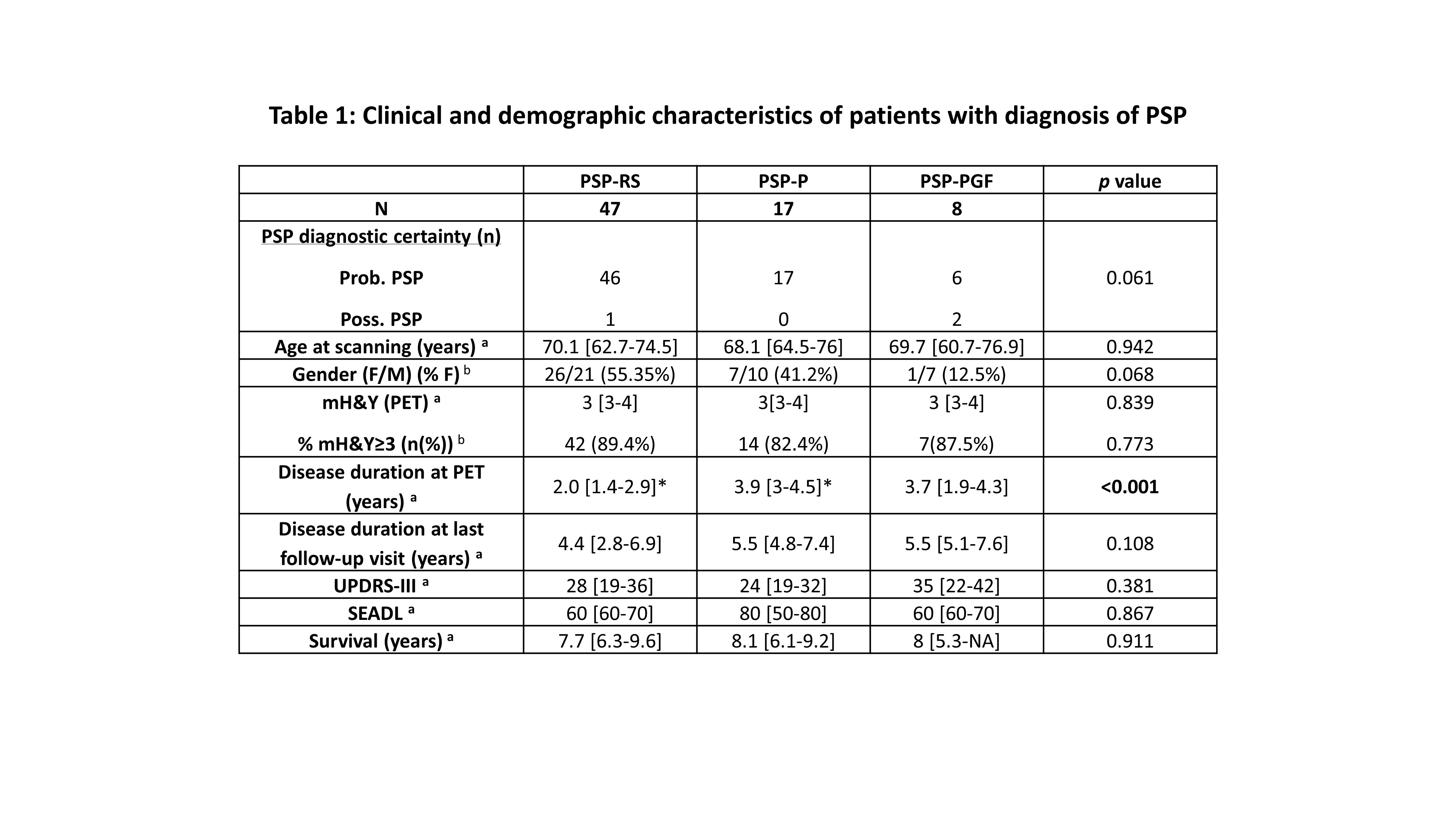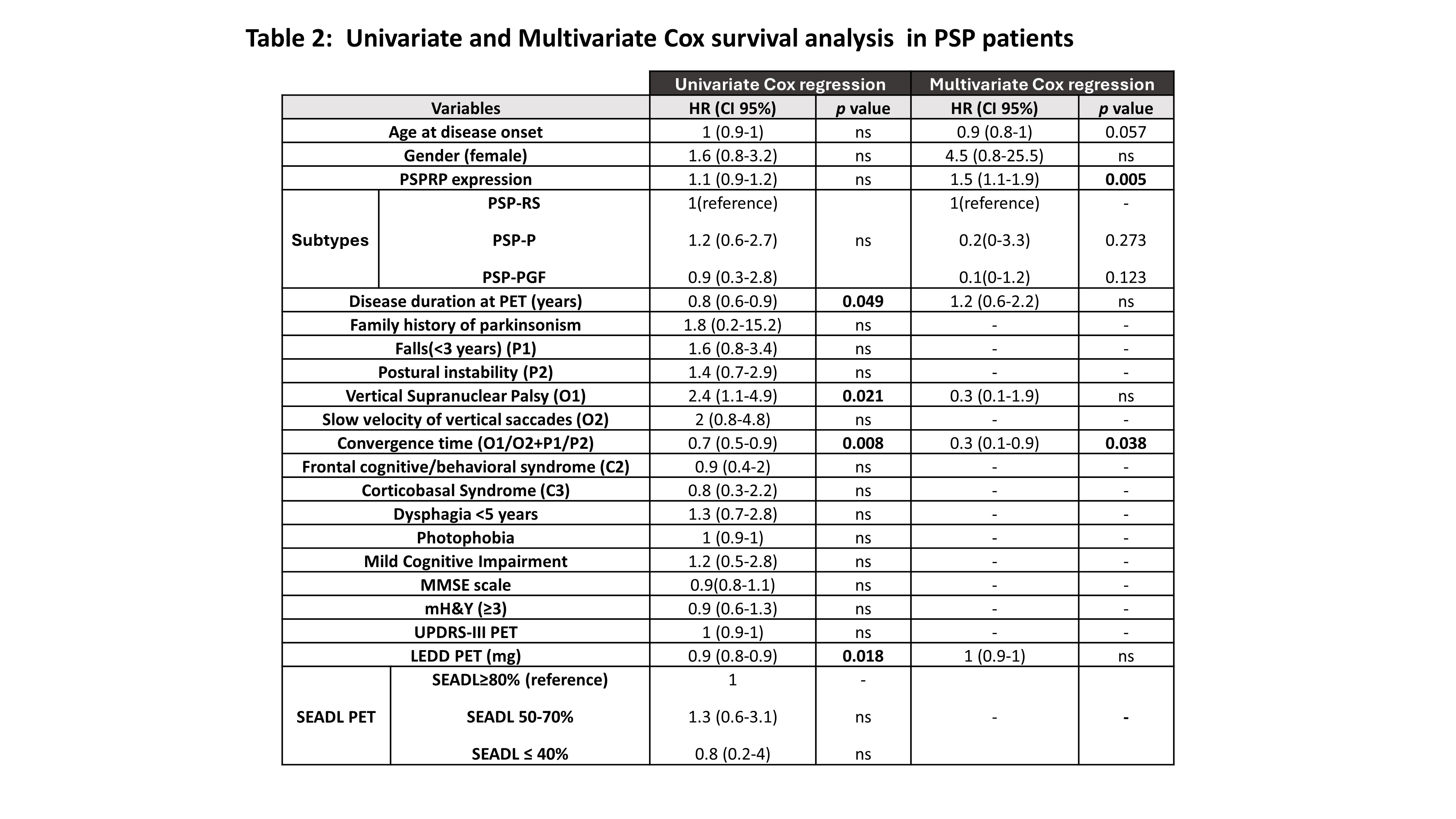Category: Parkinsonism, Atypical: PSP, CBD
Objective: To assess clinical and neuroimaging factors associated with survival in a cohort of patients with a final clinical diagnosis of Progressive Supranuclear Palsy (PSP) according to the MDS-PSP criteria.
Background: Several studies have revealed clinical factors associated with a higher risk of mortality in PSP patients, particularly in PSP-RS phenotype1–4. It remains unclear whether the inclusion of different PSP phenotypes would modify the typical clinical factors associated with mortality in patients with a diagnosis of PSP. Moreover, the influence of FDG-PET findings on survival in PSP patients have been barely studied.
Method: We performed a multicenter retrospective cohort study of 73 PSP patients referred for an FDG-PET scan throughout the disease course. We performed a systematic review of medical records and obtained clinical and imaging variables, including the date of death or last follow-up visit date in subjects who were alive in December 2022. We included the individual expression of a predefined PSP-related pattern (PSPRP)5 obtained using a multivariate Scaled Subprofile Model/Principal Component Analysis (SSM/PCA) into FDG-PET scans. A Kaplan-Meier test was performed to calculate the median of survival. The risk of death in PSP patients was calculated using a Cox proportional hazard model in univariate analysis. We also selected variables that had previously been identified as predictors of survival and/or variables with biological plausibility. Those variables were included in the multivariate Cox regression model.
Results: Clinical variables are described in [Table1]. PSP patients were followed up for a median of 5.3 years and a total of 31 PSP patients died. The median overall survival was 7.7 [5.6-9.2] years and we did not find differences between subtypes. Shorter convergence time (time to develop oculomotor (O1/O2) and postural instability (P1/P2) domains) and higher PET-FDG PSPRP expression were independent risk factors of mortality [Table 2].
Conclusion: A shorter convergence time and a more extensive PSP typical neural network dysfunction (PSPRP expression) have a negative impact on survival. The lack of survival differences between PSP subtypes might be related to an inclusion bias as we included patients who reached the highest diagnostic certainty during the follow-up and may show a shorter survival.
Clinical characteristics of PSP patients
Survival analysis in PSP patients
References: 1. O’Sullivan SS, Massey LA, Williams DR, et al. Clinical outcomes of progressive supranuclear palsy and multiple system atrophy [Internet]. Brain 2008;131(5):1362–1372.Available from: https://academic.oup.com/brain/article-lookup/doi/10.1093/brain/awn065
2. Glasmacher SA, Leigh PN, Saha RA. Predictors of survival in progressive supranuclear palsy and multiple system atrophy: a systematic review and meta-analysis [Internet]. J. Neurol. Neurosurg. Psychiatry 2017;88(5):402–411.Available from: https://jnnp.bmj.com/lookup/doi/10.1136/jnnp-2016-314956
3. dell’Aquila C, Zoccolella S, Cardinali V, et al. Predictors of survival in a series of clinically diagnosed progressive supranuclear palsy patients [Internet]. Parkinsonism Relat. Disord. 2013;19(11):980–985.Available from: http://dx.doi.org/10.1016/j.parkreldis.2013.06.014
4. Chiu WZ, Kaat LD, Seelaar H, et al. Survival in progressive supranuclear palsy and frontotemporal dementia. J. Neurol. Neurosurg. Psychiatry 2010;81(4):441–445.
5. Martí‐Andrés G, Bommel L, Meles SK, et al. Multicenter Validation of Metabolic Abnormalities Related to PSP According to the MDS‐PSP Criteria [Internet]. Mov. Disord. 2020;35(11):2009–2018.Available from: https://onlinelibrary.wiley.com/doi/abs/10.1002/mds.28217
To cite this abstract in AMA style:
G. Martí-Andrés, E. Prieto-Azcarate, CA. Espinoza-Vinces, L. van Bommel, S. Meles, M. Riverol, KL. Leenders, J. Arbizu, MR. Luquin-Puido. Clinical and neuroimaging factors associated with survival in Progressive Supranuclear Palsy [abstract]. Mov Disord. 2024; 39 (suppl 1). https://www.mdsabstracts.org/abstract/clinical-and-neuroimaging-factors-associated-with-survival-in-progressive-supranuclear-palsy/. Accessed October 17, 2025.« Back to 2024 International Congress
MDS Abstracts - https://www.mdsabstracts.org/abstract/clinical-and-neuroimaging-factors-associated-with-survival-in-progressive-supranuclear-palsy/


